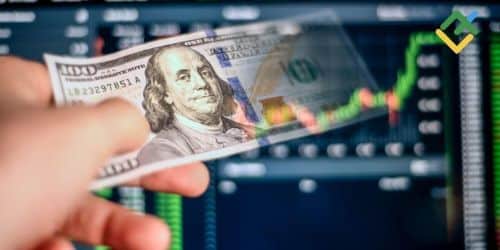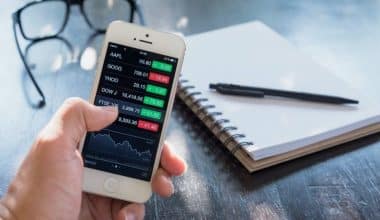To trade on margin, you must have a margin account, which means a standard brokerage account that allows you to borrow funds and use them to trade with the current cash or investment (securities) in your account as collateral for the loan. This article talks about trading on margin, bitcoin trading, day trading with its margin call, and margin example. Before we continue, let’s discuss a little about trade and margin.
Trading is the act of selling and buying products and services in businesses, just like an exchange. While margin means an extreme edge, it can also mean a limited place or space, or even a business profit, or equity an investor has in a deal with the brokerage.
In business, margin means the money an investor borrows from a broker to purchase an investment to trade. The total sale you make in your investment is what you will use to pay back the loan with interest.
What Is Trading on Margin?
Trading on margin means allowing investors to borrow funds from a broker to trade on financial assets. Which makes up the interest and collateral for the loan from the broker.
It is also the act of borrowing money from a brokerage firm in order to carry out trades for financial or security purposes. The borrower must deposit cash that serves as collateral for the loan, then pay ongoing interest on the money they borrow.
To trade on margin, you should have a brokerage firm account that is different from any other cash account, which allows you to buy more stock (securities) than you usually would. It allows you to buy a large quantity of stock and increases your buying power. Before you buy, you must first deposit cash that serves as collateral, which in turn the stock you bought changes to the collateral of the loan automatically. In turn, you pay the interest on the loan you borrowed at a later date specified in the agreement.
Bitcoin Trading on Margin
Bitcoin trading on margin can also be called a cryptocurrency margin trade. It means borrowing funds from an exchange and using them to make a trade. It is also known as “leveraging up,” which means trading with leverage beyond the existing capital they have to work with. Bitcoin trading is also the act of buying low and selling high. That is, when you buy a bitcoin, you invest in it and check the market price to see when it rises to sell.
Leveraged trading is when investors borrow capital at a high interest rate to increase their leverage, and it is risky trading. For example, some bitcoin trading exchanges can exchange for 2.5:1, 3.3:1, 20:1, 100:1, or even 1:1 leverage margin, meaning the investor has one bitcoin and can borrow 100% of their leverage capital to get more profit.
If any loss comes up, it can lead to margin calls (to add more funds to the account) and liquidation (loss of money and closing of the trade, no more cash to go further). Bitcoin margin trading services are; CEX.10, BitMEX, Binance, e.t.c.
Trading On Margin Example
- One example of trading on margin is if you have securities worth $10,000 and you purchase with a loan of $5,000 and $5,000 in cash when the security value rises by 15% to $15,000, and you are to settle the broker with the loan of $5,000, your equity or profit is $10,000.
- You want to buy 100 securities currently trading for $20 a share, and you only have $2,000 in your brokerage account. You can decide to use the cash to pay for half of the securities(50), and buy the other 50 securities on margin by borrowing $2,000 from your brokerage company, so as to invest in a total of $4,000.
- In trading on margin, the broker can double your profit with the same amount of cash. That is a gain in your investment; if you keep up the investment, you can achieve your purpose. If you make an investment of $2,000 and get $4,000. When the market price rises by 5%, you pay off the debt. That is $2,000 remaining with a $1,000 profit. Together with the $2,000 profit, that is $3,000. You invest in it when the market is high and get a gain of $5,000. it is also an example of trading on margin.
- If you have a loss situation due to a decrease in the market price, you can lose your investment. After making sales, you have to pay off your debt, and there will be nothing to trade with on margin. If the market price reduces the more you might own the brokerage and can not make any purchases again no more investment.
How Does Trading on Margin Work?
As an individual that wants to do trading on margin, here are the steps to take;
- To trade on margin, you have to find a good broker and register and know about its existence. Some brokers will want you to maintain a minimum of $2,000 in your account to borrow on margin.
- The broker checks your credit limit amount and considers whether you can borrow based on the price of the stock to be purchased. The broker can permit you to borrow up to half (50%) of the purchase price of the stock with fixed collateral in the account. For example, in trading on margin, if you want to buy $3,000 of securities and put half of that on margin, you need to have enough cash in the account to cover $1,500 of the purchase and to borrow the other $1,500 on margin.
- The broker is the one to provide collateral for the loan; it can be funds, stocks, e.t.c., which serves as a security deposit and makes the loan secure.
- When paying the loan, there is also a fixed interest set by the brokerage. It depends on the type of brokerage and the quantity of stock you are buying. If you buy high, you will get a low-interest rate to pay. If you buy low, you will get a high-interest rate to pay. If you make any sales, first pay off the debt of the margin loan because interest increases monthly.
Day Trading on Margin
Day trading on margin is the act of buying and selling the same stocks many times on the same trading day such that any exchange is closed on that trading day. It is also known as intraday trading, which allows investors to short-sell their positions and borrow funds to buy more shares than the amount of money that is in their account. It is also the act of selling securities that one has bought on the same trading day to close in quick profits from the stock price movement.
If you don’t have $25,000, you can’t do day trading, but if you don’t have that amount, you can do another alternative trading like making three-day trades in a five-day period, you can do a day trade in a stock market outside the U.S., opening another trading account with another broker, doing an options market, e.t.c.
To day trade, you can look out for volatile stocks whose prices can change in a short time, and stock screeners can help predict the upcoming price movement. You can also do your day trading in forex and futures.
Day Trading Margin Calls
This day trading margin call comes up when an investor’s day trading exceeds the buying power limitation. Therefore, the brokerage gives a daily trading margin call, which allows the investor or trader to deposit funds to meet the call at most five business days. If you don’t meet up with the brokerage funds, it restricts your account from making any other day trade till you meet up with the call. It is applied to all-day trades.
To avoid it, you need to plan your day trade and disable the money market sweep, be aware of the rules for the day trading naked options and your DTBP number on the start day, e.t.c.
Is It Better to Trade On Margin or Cash?
Cash accounts are the choice that is most frugal because they do not permit investors to borrow money from their brokers or other financial institutions in order to purchase stocks. It is possible to borrow money from your broker in order to trade or invest using a margin account. While this could potentially increase the rewards you receive, it also comes with additional hazards.
How Does Margin Work in Forex?
Margin is merely a fraction of your funds that is set aside by your forex broker from your account balance in order to keep your transaction open and to ensure that you are able to cover any potential losses incurred as a result of the deal. During the course of the particular transaction, this fraction is considered “utilized” or “locked up.”
Can Anyone Open a Margin Trading Account?
In order to start a margin account, you are required to make a cash deposit of at least $2,000 or, more commonly, double that amount in fully-paid qualifying securities. It is essential to keep in mind that trading on margin carries an element of risk. You should have a solid understanding of the margin account requirements in addition to the associated dangers before opening one.
Rules on Trading on Margin
The Margin Call
This is a level whereby the broker forces you to add more money to your account to sell your stocks and pay your debt. When they issue the margin call, and you do not meet up in settling the debt, the brokerage will close your position and bring your account to minimum value so as to pay the debt. They do this without your permission. The margin call also occurs on the day trading margin.
Maintenance Call
For your trading on a margin account, your broker advises you to leave a minimum of $2,000 in your account for maintenance of the account. That is 25% of your equity in your account. It is known as the FINRA 4210 rule. It is also in the day trading margin before the occurrence of the margin call.
Is Margin Trading a Good Idea?
Trading on margin comes with both perks and dangers. It gives you the ability to open larger positions and trade assets that you would not be able to afford otherwise. It also raises the possibility of suffering greater financial losses. Your capacity for taking on risk and the kinds of trades you want to make will determine whether or not margin trading is an appropriate option for you.
What Is the Main Benefit of Margin Trading?
When you trade in a margin account, on the plus side, you normally have the ability to borrow fifty percent of the total cost of any new securities you buy. That translates to the fact that you can acquire up to twice as many shares as you could with a cash account, and this may enable you to capitalize on short-term market opportunities without having to liquidate any of your existing investments.
What Is the Different Between Leverage vs Margin?
You can boost the amount that you are able to spend by using a margin account. You are able to trade larger positions than the amount of cash that is currently in your account when you use leverage. Margin and leverage have a relationship that is the opposite of what you may expect: the larger the margin need, the lower your leverage ratio will be.
Conclusion
Trading on margin is also called buying on margin, which allows you to invest, it can be stocks like securities or funds like bitcoin, e.t.c. It is risky to venture into it. You have to know about its existence, and you can seek professional assistance. When you settle your debt when trading on margin, you pay with interest.
When opening an account on margin, the broker gets your consent before opening the account. This article helps tell you about trading on margin. how to day trading on margin and its call.
Trading On Margin FAQs
What is the pro and con of trading on margin?
The benefit of margin is that if you invest, you can gain a huge amount. The con is that when you invest, you will lose a lot. On the margin, you can lose more money than you started with in the investment, which makes it risky.
Is trading on margin risky?
Trading on margin is a form of leverage that allows you, the investor, to borrow and use the fund to buy stocks and pay your ongoing interest. If the investment does not work out as you planned, you will face so many losses and that it is too risky. But you can do it if you understand the market level. Hence, you are good to go. You may seek the help of a professional.
How do you avoid margin interest?
To avoid paying interest on your margin account for your trade, you have to settle all debt for your complete trade. When withdrawing funds, make sure the cash is available in the account that does not have a margin loan on it to avoid you paying the interest.
Related Articles
- Gross Profit Margin: Formula & How to Calculate the Gross Profit margin
- WHAT IS A GOOD PROFIT MARGIN: Good Profit Margin For Your Business
- GROSS PROFIT PERCENTAGE: Definition, Formula & How to calculate
- Financial Performance: A Comprehensive Guide For Any Business(+ quick tools)
- MORTGAGE BROKER: How To Find One
- Profit and Loss Statement Explained!!! How to Read & Create P&L Statement
- WEBSITE MARKETING: Detailed Guide!






